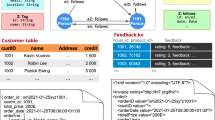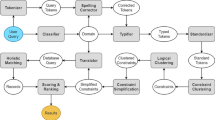Abstract
Why-not and why questions can be posed by database users to seek clarifications on unexpected query results. Specifically, why-not questions aim to explain why certain expected tuples are absent from the query results, while why questions try to clarify why certain unexpected tuples are present in the query results. This paper systematically explores the why-not and why questions on reverse top-k queries, owing to its importance in multi-criteria decision making. We first formalize why-not questions on reverse top-k queries, which try to include the missing objects in the reverse top-k query results, and then, we propose a unified framework called WQRTQ to answer why-not questions on reverse top-k queries. Our framework offers three solutions to cater for different application scenarios. Furthermore, we study why questions on reverse top-k queries, which aim to exclude the undesirable objects from the reverse top-k query results, and extend the framework WQRTQ to efficiently answer why questions on reverse top-k queries, which demonstrates the flexibility of our proposed algorithms. Extensive experimental evaluation with both real and synthetic data sets verifies the effectiveness and efficiency of the presented algorithms under various experimental settings.

























Similar content being viewed by others
References
Arnold, S.J., Handelman, J., Tigert, D.J.: The impact of a market spoiler on consumer preference structures (or, what happens when Wal-Mart comes to town). J. Retail. Consum. Serv. 5(1), 1–13 (1998)
Beckmann, N., Kriegel, H., Schneider, R., Seeger, B.: The r*-tree: an efficient and robust access method for points and rectangles. In: SIGMOD, pp. 322–331 (1990)
Berg, M., Kreveld, M., Overmars, M., Schwarzkopf, O.: Computational Geometry: Algorithms and Applications. Springer, New York (1997)
Bhagwat, D., Chiticariu, L., Tan, W.C., Vijayvargiya, G.: An annotation management system for relational databases. VLDB J. 14(4), 373–396 (2005)
Bhowmick, S.S., Sun, A., Truong, B.Q.: Why not, wine? Towards answering why-not questions in social image search. In: MM, pp. 917–926 (2013)
Bidoit, N., Herschel, M., Tzompanaki, K.: Query-based why-not provenance with nedexplain. In: EDBT, pp. 145–156 (2014)
Bidoit, N., Herschel, M., Tzompanaki, K.: Efficient computation of polynomial explanations of why-not questions. In: CIKM, pp. 713–722 (2015)
Bidoit, N., Herschel, M., Tzompanaki, K.: EFQ: why-not answer polynomials in action. In: VLDB, pp. 1980–1991 (2015)
Buneman, P., Khanna, S., Tan, W.C.: Why and where: a characterization of data provenance. In: ICDT, pp. 316–330 (2001)
Carpenter, G.S., Nakamoto, K.: Consumer preference formation and pioneering advantage. J. Mark. Res. 26(3), 285–298 (1989)
ten Cate, B., Civili, C., Sherkhonov, E., Tan, W.C.: High-level why-not explanations using ontologies. In: PODS, pp. 31–43 (2015)
Chang, Y.C., Bergman, L., Castelli, V., Li, C.S., Lo, M.L., Smith, J.R.: The onion technique: indexing for linear optimization queries. In: SIGMOD, pp. 391–402 (2000)
Chapman, A., Jagadish, H.V.: Why not? In: SIGMOD, pp. 523–534 (2009)
Chen, L., Gao, Y., Wang, K., Jensen, C.S., Chen, G.: Answering why-not questions on metric probabilistic range queries. In: ICDE (2016) (to appear)
Chen, L., Lin, X., Hu, H., Jensen, C.S., Xu, J.: Answering why-not questions on spatial keyword top-k queries. In: ICDE, pp. 297–290 (2015)
Chen, L., Xu, J., Lin, X., Jensen, C.S., Hu, H.: Answering why-not spatial keyword top-\(k\) queries via keyword adaption. In: ICDE (2016) (to appear)
Chester, S., Thomo, A., Venkatesh, S., Whitesides, S.: Indexing reverse top-k queries in two dimensions. In: DASFAA, pp. 201–208 (2013)
Chiticariu, L., Tan, W.C., Vijayvargiya, G.: Dbnotes: a post-it system for relational databases based on provenance. In: SIGMOD, pp. 942–944 (2005)
Cui, Y., Widom, J.: Lineage tracing for general data warehouse transformations. VLDB J. 12(1), 41–58 (2003)
Das, G., Gunopulos, D., Koudas, N., Tsirogiannis, D.: Answering top-k queries using views. In: VLDB, pp. 451–462 (2006)
Gao, Y., Liu, Q., Chen, G., Zheng, B., Zhou, L.: Answering why-not questions on reverse top-k queries. In: VLDB, pp. 738–749 (2015)
Ge, S., Hou, U.L., Mamoulis, N., Cheung, D.W.: Efficient all top-\(k\) computation: A unified solution for all top-\(k\), reverse top-\(k\) and top-\(m\) influential queries. IEEE Trans. Knowl. Data Eng. 25(5), 1015–1027 (2013)
Goh, K.Y., Teo, H.H., Wu, H., Wei, K.K.: Computer-supported negotiations: an experimental study of bargaining in electronic commerce. In: ICIS, pp. 104–116 (2000)
He, Z., Lo, E.: Answering why-not questions on top-k queries. In: ICDE, pp. 750–761 (2012)
He, Z., Lo, E.: Answering why-not questions on top-k queries. IEEE Trans. Knowl. Data Eng. 26(6), 1300–1315 (2014)
Herschel, M.: Wondering why data are missing from query results?: Ask conseil why-not. In: CIKM, pp. 2213–2218 (2013)
Herschel, M., Hernandez, M.: Explaining missing answers to spjua queries. In: VLDB, pp. 185–196 (2010)
Herschel, M., Hernandez, M.A., Tan, W.C.: Artemis: a system for analyzing missing answers. In: VLDB, pp. 1550–1553 (2009)
Hristidis, V., Koudas, N., Papakonstantinou, Y.: Prefer: a system for the efficient execution of multi-parametric ranked queries. In: SIGMOD, pp. 259–270 (2001)
Hristidis, V., Papakonstantinou, Y.: Algorithms and applications for answering ranked queries using ranked views. VLDB J. 13(1), 49–70 (2013)
Huang, J., Chen, T., Doan, A.H., Naughton, J.F.: On the provenance of non-answers to queries over extracted data. In: VLDB, pp. 736–747 (2008)
Islam, M., Liu, C., Li, J.: Efficient answering of why-not questions in similar graph matching. IEEE Trans. Knowl. Data Eng. 27(10), 2672–2686 (2015)
Islam, M.S., Zhou, R., Liu, C.: On answering why-not questions in reverse skyline queries. In: ICDE, pp. 973–984 (2013)
Jagadish, H.V., Chapman, A., Elkiss, A., Jayapandian, M., Li, Y., Nandi, A., Yu, C.: Making database systems usable. In: SIGMOD, pp. 13–24 (2007)
Jin, C., Zhang, R., Kang, Q., Zhang, Z., Zhou, A.: Probabilistic reverse top-k queries. In: DASFAA, pp. 406–419 (2014)
Koh, J.L., Lin, C.Y., Chen, A.L.P.: Finding k most favorite products based on reverse top-t queries. VLDB J. 23(4), 541–564 (2014)
Meliou, A., Gatterbauer, W., Moore, K.F., Suciu, D.: Why so? or why no? functional causality for explaining query answers. In: MUD, pp. 3–17 (2010)
Monteiro, R.D.C., Adler, I.: Interior path following primal-dual algorithms, part II: convex quadratic programming. Math. Program. 44(1–3), 43–66 (1989)
Padmanabhan, V., Rajiv, S., Srinivasan, K.: New products, upgrades, and new releases: a rationale for sequential product introduction. J. Mark. Res. 34(4), 456–472 (1997)
Tan, W.C.: Provenance in databases: past, current, and future. IEEE Data Eng. Bull. 30(4), 3–12 (2007)
Tao, Y., Hristidis, V., Papadias, D., Papakonstantinou, Y.: Branch-and-bound processing of ranked queries. Inf. Syst. 32(3), 424–445 (2007)
Tran, Q.T., Chan, C.Y.: How to conquer why-not questions. In: SIGMOD, pp. 15–26 (2010)
Vlachou, A., Doulkeridis, C., Kotidis, Y., Norvag, K.: Monochromatic and bichromatic reverse top-k queries. IEEE Trans. Knowl. Data Eng. 23(8), 1215–1229 (2011)
Vlachou, A., Doulkeridis, C., Norvag, K.: Monitoring reverse top-k queries over mobile devices. In: MobiDE, pp. 17–24 (2011)
Vlachou, A., Doulkeridis, C., Norvag, K., Kotidis, Y.: Identifying the most influential data objects with reverse top-k queries. In: VLDB, pp. 364–372 (2010)
Vlachou, A., Doulkeridis, C., Norvag, K., Kotidis, Y.: Branch-and-bound algorithm for reverse top-k queries. In: SIGMOD, pp. 481–492 (2013)
Xie, M., Lakshmanan, L.V.S., Wood, P.T.: Efficient top-k query answering using cached views. In: EDBT, pp. 489–500 (2013)
Xin, D., Chen, C., Han, J.: Towards robust indexing for ranked queries. In: VLDB, pp. 235–246 (2006)
Yu, A., Agarwal, P.K., Yang, J.: Processing a large number of continuous preference top-k queries. In: SIGMOD, pp. 397–408 (2012)
Zong, C., Yang, X., Wang, B., Zhang, J.: Minimizing explanations for missing answers to queries on databases. In: DASFAA, pp. 254–268 (2013)
Zou, L., Chen, L.: Dominant graph: An efficient indexing structure to answer top-k queries. In: ICDE, pp. 536–545 (2008)
Acknowledgments
This work was supported in part by the 973 Program under Grant No. 2015CB352502, the NSFC under Grant Nos. 61522208, 61379033, and 61472348, and the Fundamental Research Funds for the Central Universities under Grants No. 2015XZZX004-18 and 2015XZZX005-17. We also would like to express our gratitude to anonymous reviewers for providing valuable and helpful comments to improve this paper.
Author information
Authors and Affiliations
Corresponding author
Rights and permissions
About this article
Cite this article
Liu, Q., Gao, Y., Chen, G. et al. Answering why-not and why questions on reverse top-k queries. The VLDB Journal 25, 867–892 (2016). https://doi.org/10.1007/s00778-016-0443-4
Received:
Revised:
Accepted:
Published:
Issue Date:
DOI: https://doi.org/10.1007/s00778-016-0443-4




